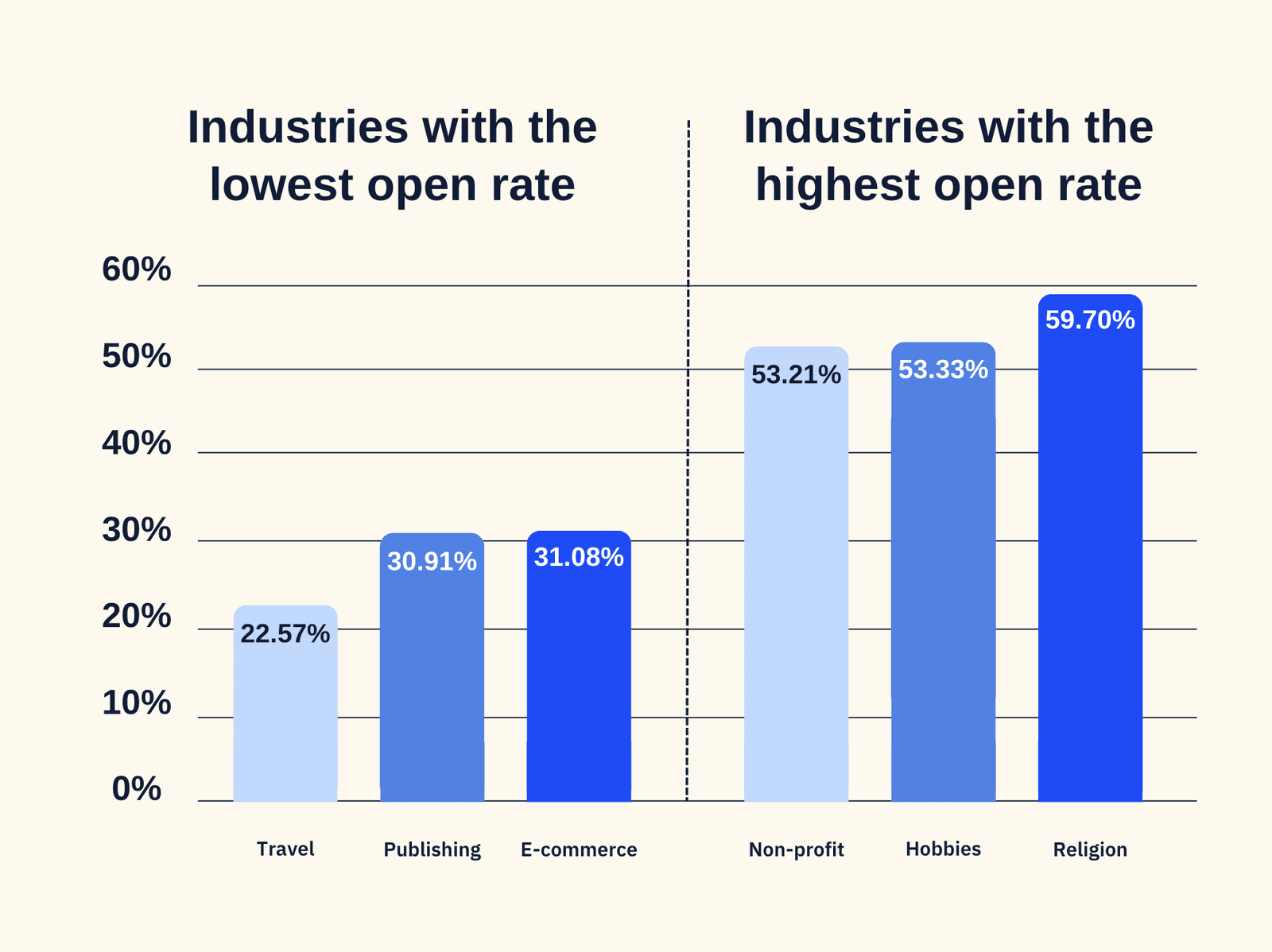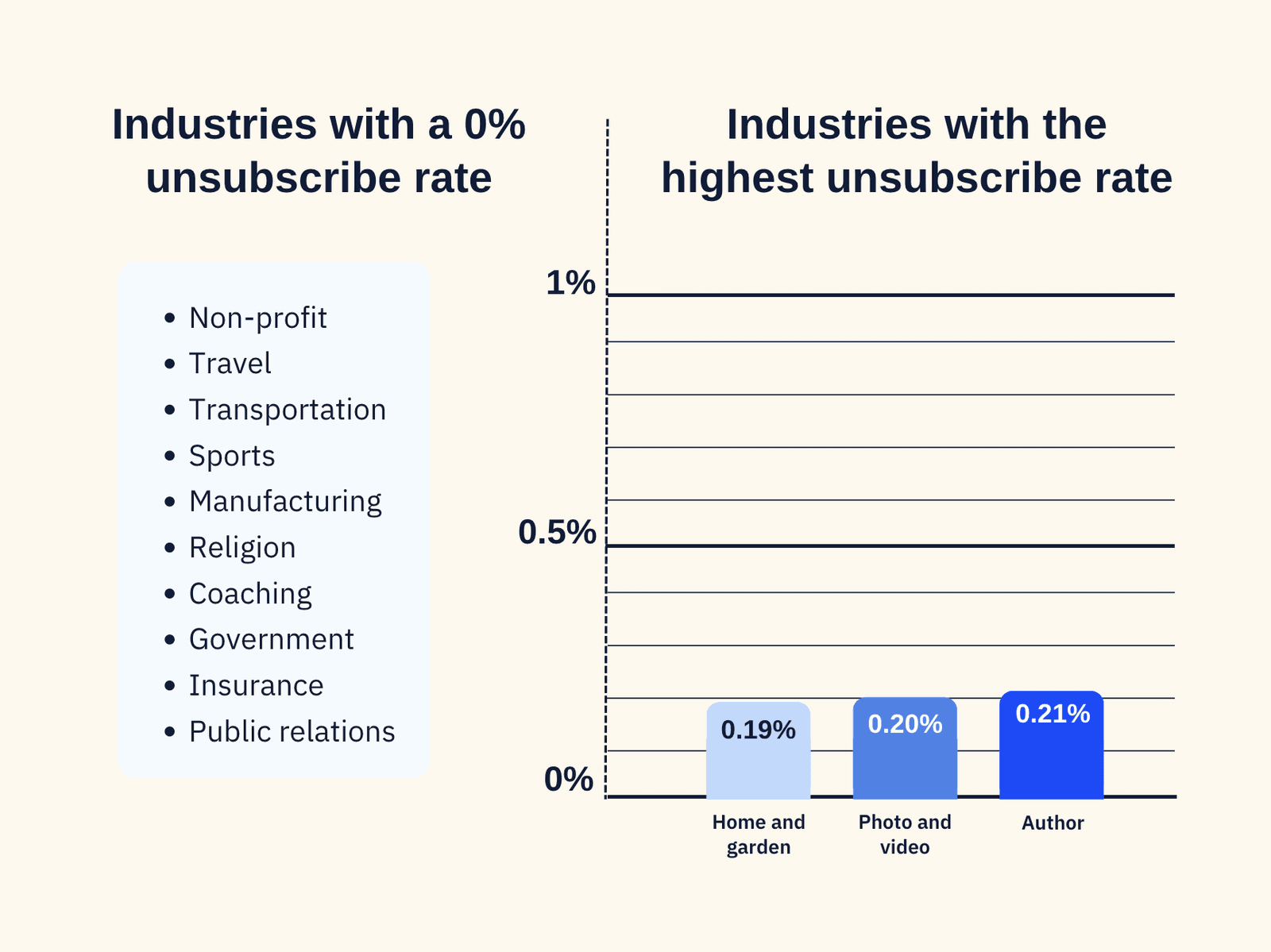Email Marketing Benchmarks
Definition
Definition
Email marketing benchmarks are industry standards that help businesses measure the success of their email campaigns by comparing key performance metrics to average engagement rates.
Common benchmarks include open rates (the number of people who open an email), click-through rates (the number of people who click a link), bounce rates (the number of emails that fail to reach the inbox), unsubscribe rates (the number of people who opt out), and conversion rates (the number of recipients who take a desired action, like making a purchase).
In this breakdown, we’ll look at common email marketing metrics and their averages to help you understand how your email campaign performance aligns with industry norms.
Email open rate benchmarks
An email open rate measures the percentage of email list recipients who open a specific email out of the total number of emails delivered. According to recent data sampled from over 3.3M email marketing campaigns, a good open rate for email marketing is around 42.35%.
The data also reports on the industries with the highest and lowest average open rates:

Source: MailerLite
Other notable industries and their respective open rates include:
- Health and fitness — 48.9%
- Marketing and advertising — 39.05%
- Agencies — 38.89%
- Entertainment and events — 43.79%
- Online courses — 43.81%
- Software and web apps — 38.14%
- Retail — 37.5%
- Restaurant — 43.69%
- Higher education — 43.37%
Read more about average open rates.
Email click-through rate benchmarks
An email click-through rate (CTR) measures the percentage of recipients who clicked on one or more links within an email out of the total number of emails delivered. A good average email click-through rate for email marketing typically ranges from 0.77% to 4.36%.
The average click-through rate across industries is around 2.62%.
Keep in mind that the click rate of an email heavily depends on the number of links included. If your emails have fewer links or lack a call-to-action, the click rate may be low, but that doesn’t necessarily mean recipients aren’t engaging with your content.
The highest and lowest average click-through rates are as follows:

Source: MailerLite
Other notable industries and their respective open rates include:
- Administrative and business support services (billing, phone answering, hiring, etc.) — 2.10%
- Legal services — 1.93%
- Nonprofit membership organizations — 1.95%
- Real estate — 1.22%
- Education — 1.66%
- Healthcare (physicians, home care, dentists, mental care, nutrition, etc.) — 0.88%
Read more about average email click-through rates.
Email bounce rate benchmarks
Before we talk about what a good bounce rate is, we need to distinguish the difference between hard and soft bounces.
A hard bounce happens when an email permanently fails to be delivered. This usually happens because the recipient’s address is invalid, doesn't exist, or has blocked your emails.
A soft bounce is a temporary delivery failure caused by issues like a full inbox, a server problem, or an email that’s too large. While soft bounces may still reach the recipient later, email addresses that hard bounce should be removed from your list to maintain good email deliverability.
Broadly, an email bounce rate is the percentage of emails that couldn't be delivered to recipients' inboxes out of the total emails sent. A good average email bounce rate for email marketing is less than 2%.
A bounce rate below 1% is ideal and reflects a well-maintained email list. If your bounce rate exceeds 2%, it could signal issues with list quality and may require cleaning to improve deliverability.
Average email bounce rates across industries:
- Business and finance organizations — 0.55%
- Construction — 1.28%
- Agriculture and food services — 0.5%
- Beauty and personal care — 0.33%
- Consulting — 0.79%
- Creative services and agencies — 0.93%
Keep in mind that the average rate for any metric will fundamentally depend on the source of data that is tested. Many different email service providers have tested their data year over year, and each report will have different averages for each metric.
Relevant content on bounce rates:
Email unsubscribe rate benchmarks
An email unsubscribe rate measures the percentage of recipients who opt out of your mailing list after receiving an email. A good unsubscribe rate for email marketing is below 0.5%. Anything under 0.2% is considered excellent.
Average unsubscribe rate breakdown:
- Excellent: Below 0.2%
- Good: 0.2% – 0.5%
- Average: 0.5% – 1%
- Poor: Above 1%
Based on recent data, the industries with the highest and lowest unsubscribe rates are as follows:

Source: MailerLite
Other industries and their respective unsubscribe rates include:
- Health and fitness — 0.12%
- Consulting — 0.05%
- E-commerce — 0.13%
- Marketing and advertising — 0.01%
- Online courses — 0.10%
- Software and web apps — 0.14%
- Retail — 0.14%
- Medical, dental, and healthcare — 0.11%
- Higher education — 0.02%
Learn more about reducing your unsubscribe rate.
Email deliverability benchmarks
Email deliverability rate refers to the percentage of sent emails that successfully reach recipients' inboxes. According to EmailTooltester’s deliverability study, a good average deliverability rate for email marketing is over 89%.
A deliverability rate of over 89% is considered good.
A deliverability rate of over 95% is considered excellent.
A deliverability rate below 80% is considered poor.
As shocking as it sounds, nearly 1 in 6 marketing emails never reach the inbox because of poor deliverability.
A good email deliverability rate matters because if your emails don’t reach inboxes, they can’t do their job. The higher your deliverability, the better your chances of getting opens, clicks, and engagement. Even the best emails won’t make an impact if they’re stuck in spam or blocked.
Keeping your list clean, using proper sender authentication, and maintaining a good reputation all help ensure your emails actually get seen—and that’s the whole point of email marketing.
EmailTooltester rated the top five best and worst email service providers for email deliverability, and they’re as follows:
Best:
ActiveCampaign (94.2%)
ConstantContact (91.7%)
GetResponse (90.9%)
Moosend (90.1%)
CleverReach (90.0%)
Worst:
AWeber (83.1%)
Hubspot (77.7%)
Omnisend (75.1%)
Benchmark (47.1%)
Learn more about email deliverability.
How to improve your benchmarks with ActiveCampaign
There are hundreds of marketing tools that can help you improve your email strategy, but one packs more punch with every feature.
ActiveCampaign can help you improve your email marketing benchmarks thanks to its advanced automation, superior deliverability, pre-built email templates, and smarter audience segmentation. With features like automated email sequences, predictive sending, and in-depth contact insights, you can send the right message at the right time—boosting open rates, click-through rates, and conversions.
Plus, ActiveCampaign’s powerful marketing automation helps keep your list clean and engaged, reducing bounce and unsubscribe rates while making sure your emails actually reach inboxes.
The results speak for themselves
Before adopting ActiveCampaign, the YMCA struggled with sending the right message to the right member at the right time, often resulting in generic communications and a bad sender reputation.
When they made the switch, the YMCA used ActiveCampaign’s behavioral trigger emails to add a tag to a contact’s profile after they clicked on a program link. This automatically moved them into a new email nurture sequence focused on that interest, leading to an impressive 12.8% click-through rate, far surpassing the industry average of 2%.
The YMCA also used ActiveCampaign’s AI Brand Kit. By preloading their logo, fonts, and color schemes, team members could easily select a template and create a professional email in minutes.
“Before we had these brand templates, I had to build every email myself. Now, anyone on our team can create an email that meets our brand standards,”
— Adam Sakry, Digital Marketing Specialist
Improve your email marketing performance today. Sign up for a free two-week trial.
* The data referenced on this page is based on studies from MailerLite, Constant Contact, Forbes, MailTrap, Mailchimp, and EmailTooltester.